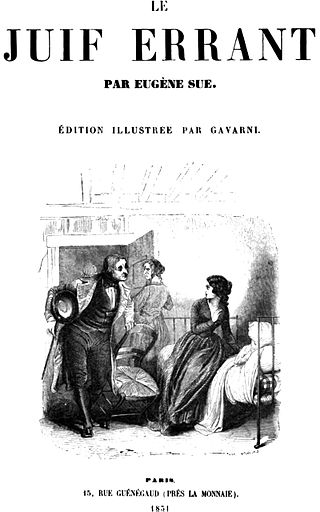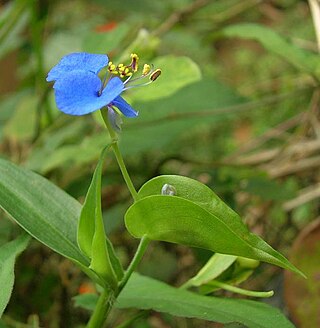The Wandering Jew is a character from Christian legend.
Contents
Wandering Jew can also refer to:
The Wandering Jew is a character from Christian legend.
Wandering Jew can also refer to:
Several trailing species of Tradescantia , also called spiderworts, inchplants, and wandering dudes:
Four species of dayflower:

Tradescantia is a genus of 85 species of herbaceous perennial wildflowers in the family Commelinaceae, native to the Americas from southern Canada to northern Argentina, including the West Indies. Members of the genus are known by many common names, including inchplant, wandering jew, spiderwort, dayflower and trad.

The Wandering Jew is a mythical immortal man whose legend began to spread in Europe in the 13th century. In the original legend, a Jew who taunted Jesus on the way to the Crucifixion was then cursed to walk the Earth until the Second Coming. The exact nature of the wanderer's indiscretion varies in different versions of the tale, as do aspects of his character; sometimes he is said to be a shoemaker or other tradesman, while sometimes he is the doorman at the estate of Pontius Pilate.
Wanderer, Wanderers, or The Wanderer may refer to:

Tradescantia pallida is a species of spiderwort native to the Gulf Coast region of eastern Mexico. The cultivar T. pallida 'Purpurea' is commonly called purple secretia, purple-heart, or purple queen. Edward Palmer collected the type specimen near Ciudad Victoria, Tamaulipas in 1907.

Tradescantia zebrina, formerly known as Zebrina pendula, is a species of creeping plant in the Tradescantia genus. Common names include silver inch plant and wandering Jew. The latter name is controversial, and some now use the alternative wandering dude. The plant is popular in cultivation due to its fast growth and attractive foliage. It is used as a groundcover in warm winter climates, and as a houseplant elsewhere.

Tradescantia fluminensis is a species of spiderwort native to South America. It is one of several plants known by the common name wandering Jew. It is also known as small-leaf spiderwort, river spiderwort, inch plant, speedy Henry, wandering willie and wandering trad.

Raphanus raphanistrum, also known as wild radish, white charlock or jointed charlock, is a flowering plant in the family Brassicaceae. One of its subspecies, Raphanus raphanistrum subsp. sativus, includes a diverse variety of cultivated radishes. The species is native to western Asia, Europe and parts of Northern Africa. It has been introduced into most parts of the world and is regarded as a habitat threatening invasive species in many areas, for example, Australia. It spreads rapidly and is often found growing on roadsides or in other places where the ground has been disturbed.

The Wandering Jew is an 1844 novel by the French writer Eugène Sue.
The cherry is the fruit of many plants of the genus Prunus. The plants themselves are also called cherries, and the wood they produce is called cherry.
The Purple Heart is a United States military decoration.

Tradescantia virginiana, the Virginia spiderwort, is a species of flowering plant in the family Commelinaceae. It is the type species of Tradescantia, native to the eastern United States. It is commonly grown in many gardens and also found growing wild along roadsides and railway lines.

Commelina caroliniana, sometimes known as the Carolina dayflower, is an herbaceous plant in the dayflower family native to India and Bangladesh. Both the scientific name and the common name are misleading as the plant was described based on specimens found in the southeastern United States before it was known that the plant had in fact been introduced from India. It was most likely introduced to South Carolina in the late 17th century along with rice seed from India. The plant has also been recently reported from South Korea. Its flowers emerge from summer to fall and rarely into the winter.

Commelina benghalensis, commonly known as the Benghal dayflower, tropical spiderwort, or wandering Jew, kanshira in Bengali, is a perennial herb native to tropical Asia and Africa. It has been widely introduced to areas outside its native range, including to the neotropics, Hawaii, the West Indies and to both coasts of North America. It has a long flowering period, from spring to fall in subtropical areas, and throughout the year closer to the equator. It is often associated with disturbed soils.

Commelina cyanea, commonly known as scurvy weed, is a perennial prostrate herb of the family Commelinaceae native to moist forests and woodlands of eastern Australia, Lord Howe Island and Norfolk Island. The blue flowers appear over the warmer months and are pollinated by bees and flies.

The angulate tortoise is a species of tortoise found in dry areas and coastal scrub vegetation in South Africa. This tortoise is the only known member of the genus Chersina.

Tradescantia crassula, common names succulent spiderwort and white-flowered tradescantia, is a species of plants in the Commelinaceae. It is native to southeastern Brazil, Uruguay, and the Misiones Province of Argentina, and has been introduced to Florida. It flowers in May in Florida, and can be found under Oak Trees.

Tradescantia sillamontana is a perennial evergreen herbaceous plant of the genus Tradescantia. This species is one of the most succulent and xerophytic, but at the same time one of the most attractive species of Tradescantia. It is endemic to dry areas of the State of Nuevo León in northeastern Mexico and can also be found in Spain and Italy.
The Eternal Jew is a calque of the German Der Ewige Jude, referring to the Wandering Jew archetype. It may refer to:

Commelina ensifolia, commonly known as scurvy weed, scurvy grass or wandering Jew, is an annual herb native to Australia, India, and Sri Lanka.
Scurvy weed is a common name for several flowering plants and may refer to: